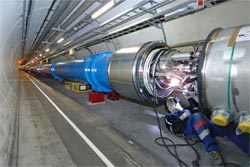CERN announces new start-up schedule for world’s most powerful particle accelerator

Interconnections on the last sector of the LHC
The LHC is a scientific instrument of unprecedented complexity, and at 27 kilometres in circumference, the world’s largest superconducting installation. Cooling the first sector of the machine to a temperature of 1.9 K (-271.3°C), colder than outer space, began earlier this year and has provided an important learning process. The first sector cool down has taken longer than scheduled, but has allowed the LHC’s operations team to iron out teething troubles and gain experience that will be applied to the machine’s seven remaining sectors. Now cold, tests on powering up the sector have begun and the cool down of a second sector will soon be underway.
In March, a magnet assembly known as the inner triplet, provided to CERN as part of the contribution of the US to the LHC project, failed a pressure test. A repair has been identified and is currently being implemented.
“The low-energy run at the end of this year was extremely tight due to a number of small delays, but the inner triplet problem now makes it impossible,” said LHC Project Leader Lyn Evans. “We’ll be starting up for physics in May 2008, as always foreseen, and will commission the machine to full energy in one go.”
The new schedule foresees successively cooling and powering each of the LHC’s sectors in turn this year. Throughout the winter, hardware commissioning will continue, allowing the LHC to be ready for high-energy running by the time CERN’s accelerators are switched on in the spring. Commissioning a new particle accelerator is a complex task. Beams will be injected at low energy and low intensity to give the operations team experience in driving the new machine. Intensity and energy will then slowly be increased.
“There’s no big red button when you’re starting up a new accelerator,” said Evans, “but we aim to be seeing high energy collisions by the summer.”
Installation of the large and equally innovative apparatus for experiments at this new and unique facility will continue at the same time. This huge effort will be completed on a schedule consistent with that of the accelerator.
In another important development, the CERN Council agreed to increase CERN’s funding over the years 2008-2011 as an important first step towards implementing the decisions Council made in July 2006 for a European strategy for particle physics.
“This is an important vote for the future of particle physics in Europe,” said CERN Director General Robert Aymar, “it allows us to consolidate the laboratory’s infrastructure, prepare for future upgrades of the LHC and to re-launch a programme of R&D for the long-term future.”
The LHC relies on a chain of particle accelerators, the oldest of which was constructed in the 1950s. Their successful operation is essential to the smooth running of the LHC. These additional resources will be used to consolidate CERN’s infrastructure, and build on it for the future.
1 CERN, the European Organization for Nuclear Research, is the world's leading laboratory for particle physics. It has its headquarters in Geneva. At present, its Member States are Austria, Belgium, Bulgaria, the Czech Republic, Denmark, Finland, France, Germany, Greece, Hungary, Italy, Netherlands, Norway, Poland, Portugal, Slovakia, Spain, Sweden, Switzerland and the United Kingdom. India, Israel, Japan, the Russian Federation, the United States of America, Turkey, the European Commission and UNESCO have Observer status
Media Contact
More Information:
http://www.cern.chAll latest news from the category: Physics and Astronomy
This area deals with the fundamental laws and building blocks of nature and how they interact, the properties and the behavior of matter, and research into space and time and their structures.
innovations-report provides in-depth reports and articles on subjects such as astrophysics, laser technologies, nuclear, quantum, particle and solid-state physics, nanotechnologies, planetary research and findings (Mars, Venus) and developments related to the Hubble Telescope.
Newest articles

Properties of new materials for microchips
… can now be measured well. Reseachers of Delft University of Technology demonstrated measuring performance properties of ultrathin silicon membranes. Making ever smaller and more powerful chips requires new ultrathin…

Floating solar’s potential
… to support sustainable development by addressing climate, water, and energy goals holistically. A new study published this week in Nature Energy raises the potential for floating solar photovoltaics (FPV)…

Skyrmions move at record speeds
… a step towards the computing of the future. An international research team led by scientists from the CNRS1 has discovered that the magnetic nanobubbles2 known as skyrmions can be…





















